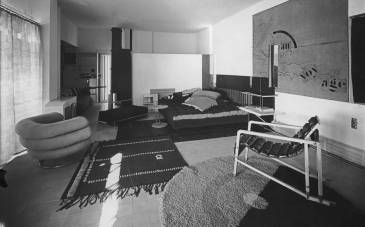A little while ago we went to the National Museum to see who this Eileen Gray was. They have a poster outside, telling you she’s great stuff altogether: she’s one of those Irish geniuses who left Ireland and never came back.
She lived most of her life in Paris, moved in interesting circles in the Twenties and Thirties, and then lived out the rest of her life in obscurity in the French capital. It being an Irish museum, it’s a little afraid to use a word like lover, so Jean Badovici is referred to as a friend, and the house she designed for him is said to have a “mysterious” name, though there’s nothing mysterious about it. She called it E.1027. The “E” was for Eileen and the “7” was for the seventh letter of the alphabet, the first letter of her surname. The other numbers represent “J” and “B”. It was her modernist way of saying: this is our gaff.
Gray and Badovici went on exotic trips together, to Peru (in 1929), to Mexico (in 1934), and Eileen was one of these people who drove around in an MG but hardly knew how to boil and egg. You don’t get any of that in the exhibition. Whoever put it together didn’t go to the trouble of reading Peter Adam’s biography, or any biography.
Well, you can learn all about the two of them in that book. Gray was fourteen years older than Badovici, and she had a lot more money than he had. He asked her to build him a house in the South of France and for three years she lived down there, going to the site, working with the two of three builders, seeing hardly anyone else. He’d drop down from time to time, but you get the impression he was on the lash a lot, enjoying himself, while she lived this hermetic, dedicated life. He was a big socialiser and womaniser and she was a bit of a loner.
After this, he asks her to design a flat for him in the rue Chateaubriand, in Paris. Again she obliges him. She decks it out for him too, out of her own pocket.
So now Badovici has a gaff in the South of France, a modernist classic, and an apartment in Paris. And at a certain point they go their separate ways.
It was after they parted that Badovici’s good old pal Le Corbusier started asking all his friends if he could paint frescoes in their houses. Badovici said: “grand”. And Le Corbusier painted eight in E.1027. Eight! In this house that was all about clean lines, bare walls, very few colours. In this house that was an act of love. Well, this pissed Eileen off no end.
Old Le Corbusier: what a wanker. “Again and again Eileen was made to feel that for a woman, a mere amateur, there was little room among the elitist male-oriented group of architects,” Adam writes; that was in the late Twenties. Well, this was the cherry on top.
And Badovici. That’s him in the photo up top, pointing at the camera. A happy-go-lucky, thoughtless pisshead. (The woman in the photo is Le Corbusier’s wife, who looks as enamoured of the frescos as Eileen must have been).

